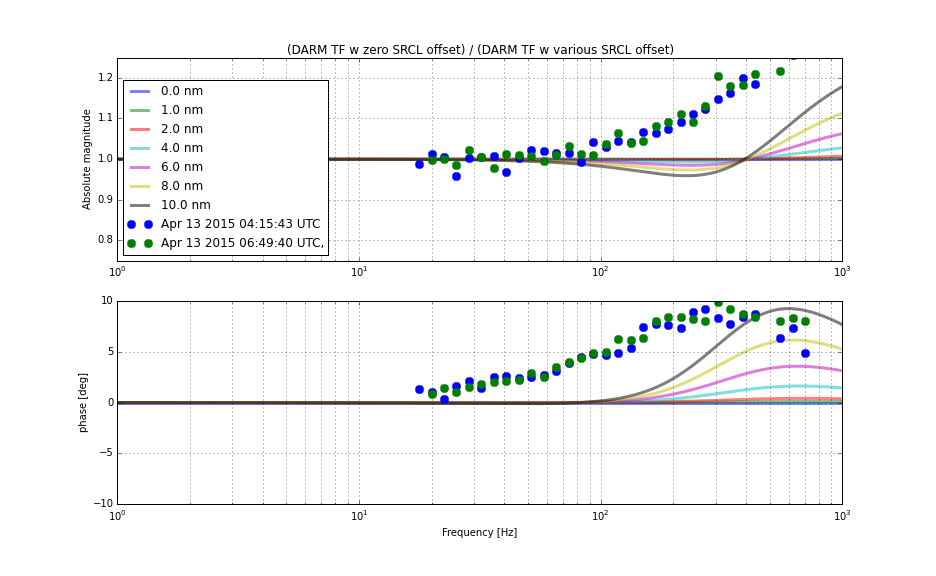J. Kissel, K. Izumi Using the same model I described yesterday (see LHO aLOG 17847), I've now compared it against (a) this weekend's measured DARM Open Loop Gain Transfer Functions (OLGTFs), which were taken out to 1 [kHz]: 2015-04-12 Post UIM / TST Crossover Adjustment, Post HAM6 Vent, ESD Linearization OFF, at 10 [W] input power LHO aLOG 17834 2015-04-13 Increase of input power to 15 [W], ESD Linearization OFF LHO aLOG 17835 and (b) The previous measurements shown in LHO aLOG 17847. They've solidified suspicions of we'd just barely begun to see -- there's definitely some funny business going on: - We suspect that the frequency dependence of the sensing function (i.e. optical plant) cannot be simply described by a single-pole filter, but it could also be a flaw in model of the actuation frequency dependence. - The optical gain has significantly reduced from 112e6+/-8% to 75e6+/-4%, even though Evan and Sheila have attempted to compensate for it in the DARM loop digital gain. In the first attachment, I compare all of the measurements against a model with a fixed cavity pole frequency of 389 [Hz], the number calculated to be the ideal from L1 (see LLO aLOG 15923). In the second attachment, I compare all of the measurements against a model where I've adjusted the coupled cavity pole frequency to match the model / measurement discrepancy. From the comparison of these two models, one can see several things: (1) There is a systematic difference in frequency-dependent discrepancy between the earlier, 5-300 [Hz] data and the later, post-HAM6 vent, data. This implies something systematic has changed in the time between 2015-04-06 and 2015-04-12. (2) In order to fit the discrepancy's frequency dependence, I've had to move the DARM coupled cavity pole down to an unrealistically (??) low 320 [Hz] and 290 [Hz] for the earlier and later data, respectively. The ?? is because I'm not sure what is unrealistic. (3) I've used the same time delay for *all* of the data sets. The 40 [us] was chosen *after* I'd shifted the coupled-cavity pole frequency down in order to get the phase to be flat as a function of frequency. We have no reason to suspect that the time delay would have changed over these 5 measurements, so I take this to be the residual unknown timing error (*not* the 93 +/- 30 [us] I'd said in the previous log). There are several things think might be the cause of this (arranged in order of what we think is most likely) - DARM coupled cavity pole is lower than expected because of SRCL offset, low power recycling gain, or IFO alignment - ESD / SUS isn't exactly 1/f^2 at high frequency - Some nasty frequency dependence of the linearization algorithm Kiwamu's hard at work testing the first suspicion. Stay tuned!
Jeff K, Kiwamu,
As Jeff described in the above entry, we noticed that the latest measured DARM open loops behaved as if they got a lower cavity pole (~ 290 Hz). There are several possible reasons for explaining this. This time, we started from study of a SRCL offset which can lower the DARM cavity pole. After the study, we are concluding that the discrepancy is NOT due to a SRCL offset.
(Comparison between model and measurements)
The attached plot below shows a ratio of the zero-SRCL-offset DARM TF and DARM TFs with various SRCL offsets together with the actual data that Jeff posted. The solid curves are made from simulated responses and dots are the measured ones. The numbers in the legend box represent the size of the offsets in the SRCL locking point.
As shown in the plot, the behavior of a rising wing at high frequencies are seen in both the measured data and simulation. However, apparently the measured data do not show a dip at around 200 Hz. As we know, this dip is a particular behavior of a SRCL offset which results in a detuning peak at around the cavity pole.
If we keep increasing the SRCL offset, the location of the cavity pole would become as low as measured one, but at the same time it would also make the dip much deeper. So we think the SRCL offset is NOT the one causing the low cavity pole in DARM.


